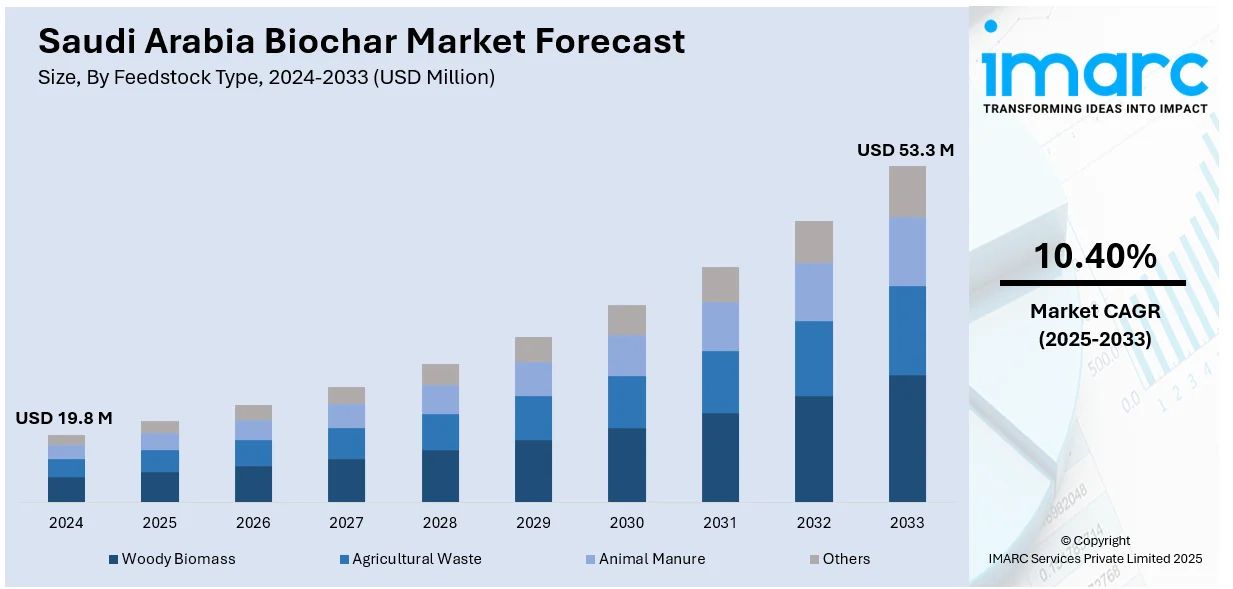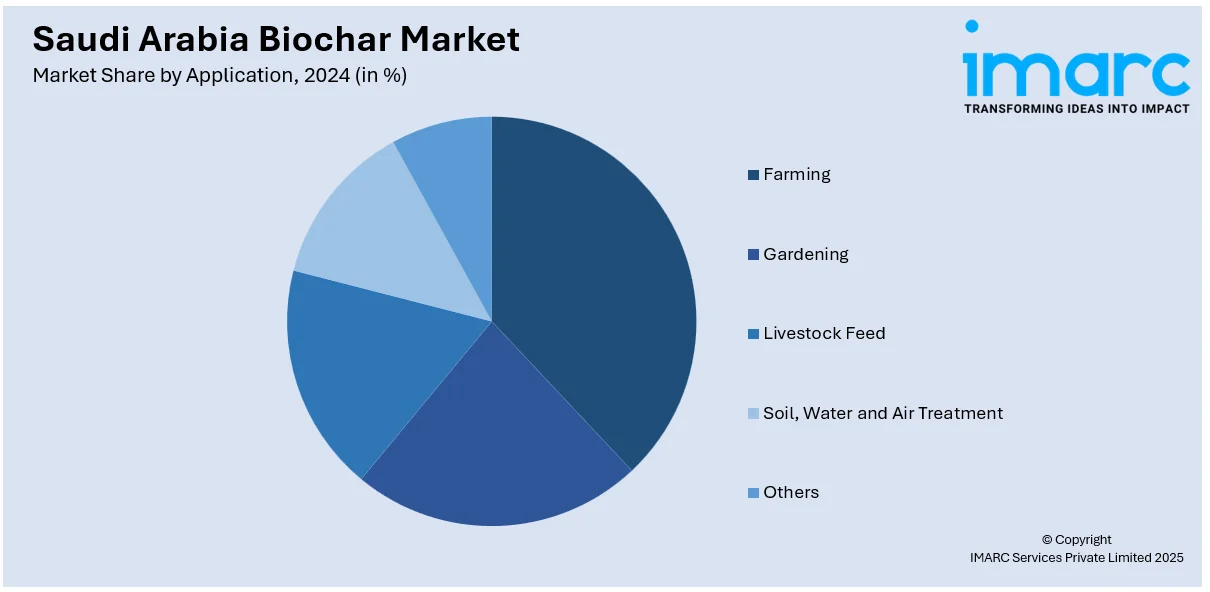
Saudi Arabia Biochar Market Size, Share, Trends and Forecast by Feedstock Type, Technology Type, Product Form, Application, and Region, 2025-2033
Saudi Arabia Biochar Market Overview:
The Saudi Arabia biochar market size reached USD 19.8 Million in 2024. Looking forward, IMARC Group expects the market to reach USD 53.3 Million by 2033, exhibiting a growth rate (CAGR) of 10.40% during 2025-2033. The market is being led by a push towards farm sustainability, with biochar enhancing soil quality, water holding capacity, and productivity under dry conditions. Further, the increasing demand for waste management and recycling based on circular economy operations has led to increasing the relevance of biochar as an effective method for recycling agricultural residues hence improving the Saudi Arabia biochar market growth.
|
Report Attribute
|
Key Statistics
|
|---|---|
|
Base Year
|
2024
|
|
Forecast Years
|
2025-2033
|
|
Historical Years
|
2019-2024
|
| Market Size in 2024 | USD 19.8 Million |
| Market Forecast in 2033 | USD 53.3 Million |
| Market Growth Rate 2025-2033 | 10.40% |
Saudi Arabia Biochar Market Trends:
Waste Management and Circular Economy
In Saudi Arabia, the growing focus on waste management and the circular economy has heightened interest in biochar production. Derived from agricultural residues such as date palm fronds, biochar offers an efficient method of transforming biomass into a valuable and sustainable resource. The process minimizes landfill waste and carbon emissions, which is a boost to the Kingdom's environmental agenda. By turning trash into biochar, Saudi Arabia can address its waste management challenges as well as propel the efforts of sustainability. Moreover, this movement provides enormous economic opportunities to companies involved in agriculture and trash disposal. As biochar production grows, so too does it fit with the broader agenda for Saudi Arabia's sustainability increase, creating new possibilities for green innovation alongside making economic diversification easier in accordance with Vision 2030.

Agricultural Sustainability and Soil Health
One of the key drivers of the Saudi Arabia biochar market outlook is the emphasis on agricultural sustainability, especially in addressing water scarcity. Saudi Arabia has launched initiatives to incorporate biochar produced from palm waste into agricultural practices, aiming to reduce water consumption by 30%. Biochar improves soil fertility by enhancing soil structure, nutrient availability, and water retention, which is crucial in arid regions with limited water resources. By retaining moisture in the soil, biochar helps reduce the need for frequent irrigation, supporting water conservation efforts. The adoption of biochar aligns with Saudi Arabia's Vision 2030, which emphasizes sustainable agricultural practices and eco-friendly farming techniques. As the agricultural sector seeks solutions for increased productivity with minimal water use, biochar plays a pivotal role in improving crop yields and soil health in dry climates.
Government Support for Green Technologies
The Saudi Arabian government’s commitment to diversifying its economy and investing in green technologies has been pivotal in impelling the Saudi Arabia biochar market share. Aligned with Vision 2030, which emphasizes renewable energy, environmental sustainability, and green technologies, biochar plays a key role in supporting sustainable agriculture, carbon sequestration, and waste reduction. The Saudi Green Initiative (SGI), with 77 active projects and investments exceeding $186 billion, accelerates these goals, fostering a favorable environment for biochar production. Government incentives, research funding, and the promotion of eco-friendly solutions contribute to the growth of this market, positioning biochar as a vital element of Saudi Arabia’s green transition. This strategic push towards sustainable technologies is central to reducing reliance on oil and advancing long-term economic and environmental objectives.
Saudi Arabia Biochar Market Segmentation:
IMARC Group provides an analysis of the key trends in each segment of the market, along with forecasts at the region level for 2025-2033. Our report has categorized the market based on feedstock type, technology type, product form and application.
Feedstock Type Insights:
- Woody Biomass
- Agricultural Waste
- Animal Manure
- Others
The report has provided a detailed breakup and analysis of the market based on the feedstock type. This includes woody biomass, agricultural waste, animal manure, and others.
Technology Type Insights:
- Slow Pyrolysis
- Fast Pyrolysis
- Gasification
- Hydrothermal Carbonization
- Others
A detailed breakup and analysis of the market based on the technology type have also been provided in the report. This includes slow pyrolysis, fast pyrolysis, gasification, hydrothermal carbonization, and others.
Product Form Insights:
- Coarse and Fine Chips
- Fine Powder
- Pellets, Granules and Prills
- Liquid Suspension
The report has provided a detailed breakup and analysis of the market based on the product form. This includes coarse and fine chips, fine powder, pellets, granules and prills, and liquid suspension.
Application Insights:

- Farming
- Gardening
- Livestock Feed
- Soil, Water and Air Treatment
- Others
A detailed breakup and analysis of the market based on the application have also been provided in the report. This includes farming, gardening, livestock feed, soil, water and air treatment, and others.
Regional Insights:
- Northern and Central Region
- Western Region
- Eastern Region
- Southern Region
The report has also provided a comprehensive analysis of all the major regional markets, which include Northern and Central, Western, Eastern, and Southern Region.
Competitive Landscape:
The market research report has also provided a comprehensive analysis of the competitive landscape. Competitive analysis such as market structure, key player positioning, top winning strategies, competitive dashboard, and company evaluation quadrant has been covered in the report. Also, detailed profiles of all major companies have been provided.
Saudi Arabia Biochar Market News:
- In December 2024, SEER, in partnership with Eco Tadweer, advanced Saudi Arabia’s Green Riyadh project by improving soil and plant health through biochar applications. The initiative, supporting Saudi Vision 2030, enhances water retention, nutrient availability, and soil structure, promoting sustainability and water conservation. It also generates carbon credits, contributing to the Saudi Green Initiative. The project demonstrates biochar’s effectiveness in sustainable land management and positions Saudi Arabia as a sustainability leader.
- In December 2024, SUEZ and the Saudi Investment Recycling Company (SIRC) formed a strategic partnership to promote circular economy initiatives in Saudi Arabia. Announced during the French President’s state visit, the collaboration focuses on developing waste-to-energy infrastructures and enhancing waste management solutions, including municipal, medical, and hazardous waste. The partnership also includes decarbonization efforts, such as biochar production, supporting the Kingdom’s Vision 2030 goals for sustainability and a low-carbon economy.
- In September 2024, Saudi Arabia launched its first biochar initiative, converting palm waste into a sustainable resource to reduce farm water use by 30%. The project, led by the National Center for Palms and Dates, enhances soil quality, boosts crop yields, and lowers greenhouse gas emissions. Aligned with the Kingdom’s circular economy goals, the initiative offers new economic opportunities and supports sustainable agriculture, contributing to environmental and economic innovation.
Saudi Arabia Biochar Market Report Coverage:
| Report Features | Details |
|---|---|
| Base Year of the Analysis | 2024 |
| Historical Period | 2019-2024 |
| Forecast Period | 2025-2033 |
| Units | Million USD |
| Scope of the Report |
Exploration of Historical Trends and Market Outlook, Industry Catalysts and Challenges, Segment-Wise Historical and Future Market Assessment:
|
| Feedstock Types Covered | Woody Biomass, Agricultural Waste, Animal Manure, Others |
| Technology Types Covered | Slow Pyrolysis, Fast Pyrolysis, Gasification, Hydrothermal Carbonization, Others |
| Product Forms Covered | Coarse and Fine Chips, Fine Powder, Pellets, Granules and Prills, Liquid Suspension |
| Applications Covered | Farming, Gardening, Livestock Feed, Soil, Water and Air Treatment, Others |
| Regions Covered | Northern and Central Region, Western Region, Eastern Region, Southern Region |
| Customization Scope | 10% Free Customization |
| Post-Sale Analyst Support | 10-12 Weeks |
| Delivery Format | PDF and Excel through Email (We can also provide the editable version of the report in PPT/Word format on special request) |
Key Questions Answered in This Report:
- How has the Saudi Arabia biochar market performed so far and how will it perform in the coming years?
- What is the breakup of the Saudi Arabia biochar market on the basis of feedstock type?
- What is the breakup of the Saudi Arabia biochar market on the basis of technology type?
- What is the breakup of the Saudi Arabia biochar market on the basis of product form?
- What is the breakup of the Saudi Arabia biochar market on the basis of application?
- What is the breakup of the Saudi Arabia biochar market on the basis of region?
- What are the various stages in the value chain of the Saudi Arabia biochar market?
- What are the key driving factors and challenges in the Saudi Arabia biochar?
- What is the structure of the Saudi Arabia biochar market and who are the key players?
- What is the degree of competition in the Saudi Arabia biochar market?
Key Benefits for Stakeholders:
- IMARC’s industry report offers a comprehensive quantitative analysis of various market segments, historical and current market trends, market forecasts, and dynamics of the Saudi Arabia biochar market from 2019-2033.
- The research report provides the latest information on the market drivers, challenges, and opportunities in the Saudi Arabia biochar market.
- Porter's five forces analysis assist stakeholders in assessing the impact of new entrants, competitive rivalry, supplier power, buyer power, and the threat of substitution. It helps stakeholders to analyze the level of competition within the Saudi Arabia biochar industry and its attractiveness.
- Competitive landscape allows stakeholders to understand their competitive environment and provides an insight into the current positions of key players in the market.
Need more help?
- Speak to our experienced analysts for insights on the current market scenarios.
- Include additional segments and countries to customize the report as per your requirement.
- Gain an unparalleled competitive advantage in your domain by understanding how to utilize the report and positively impacting your operations and revenue.
- For further assistance, please connect with our analysts.
 Request Customization
Request Customization
 Speak to an Analyst
Speak to an Analyst
 Request Brochure
Request Brochure
 Inquire Before Buying
Inquire Before Buying




.webp)




.webp)












